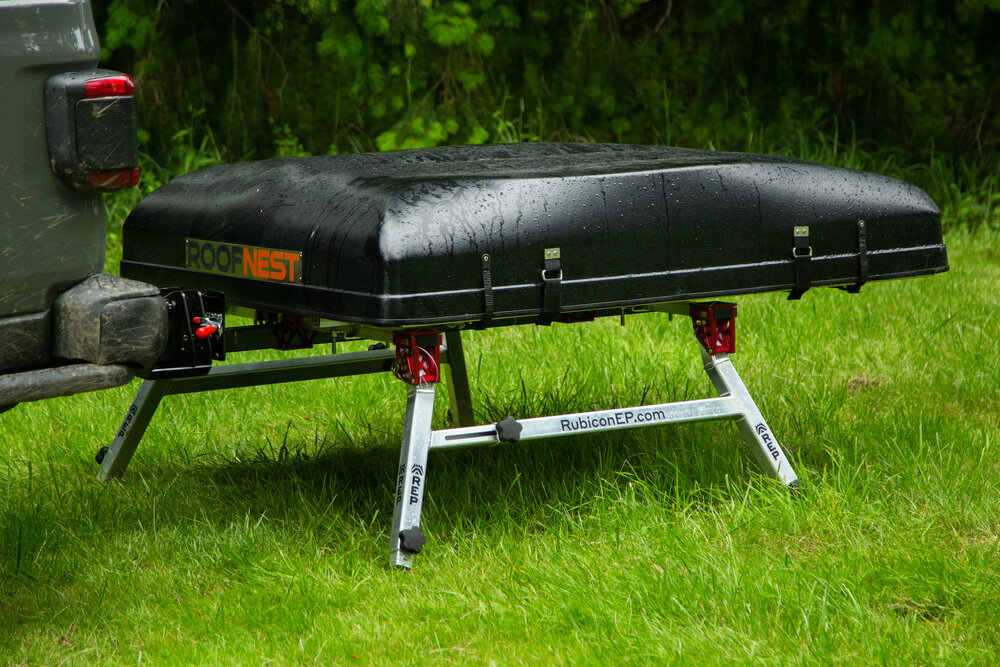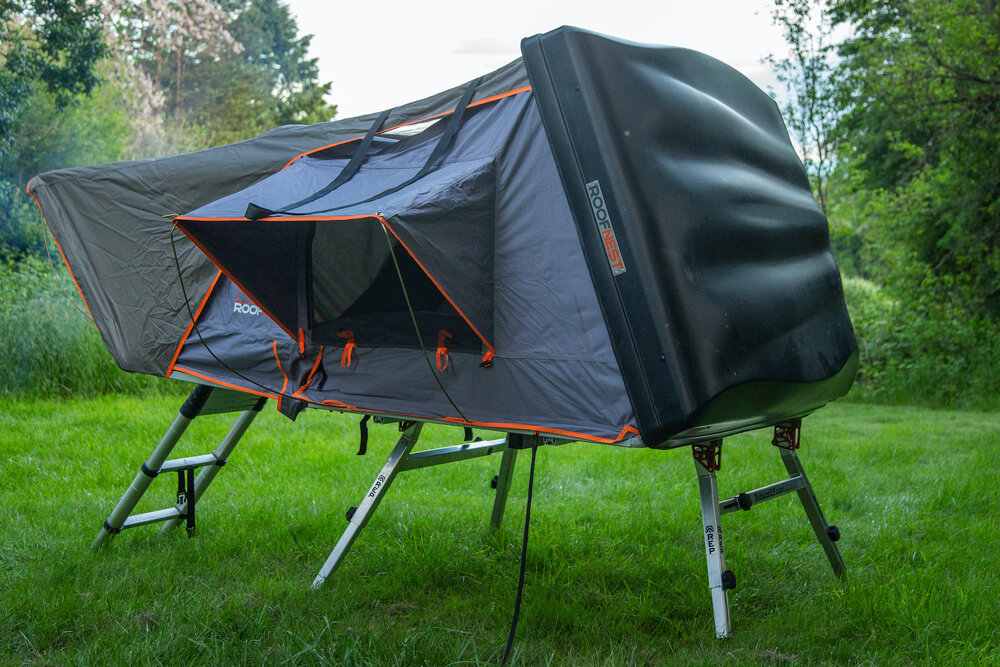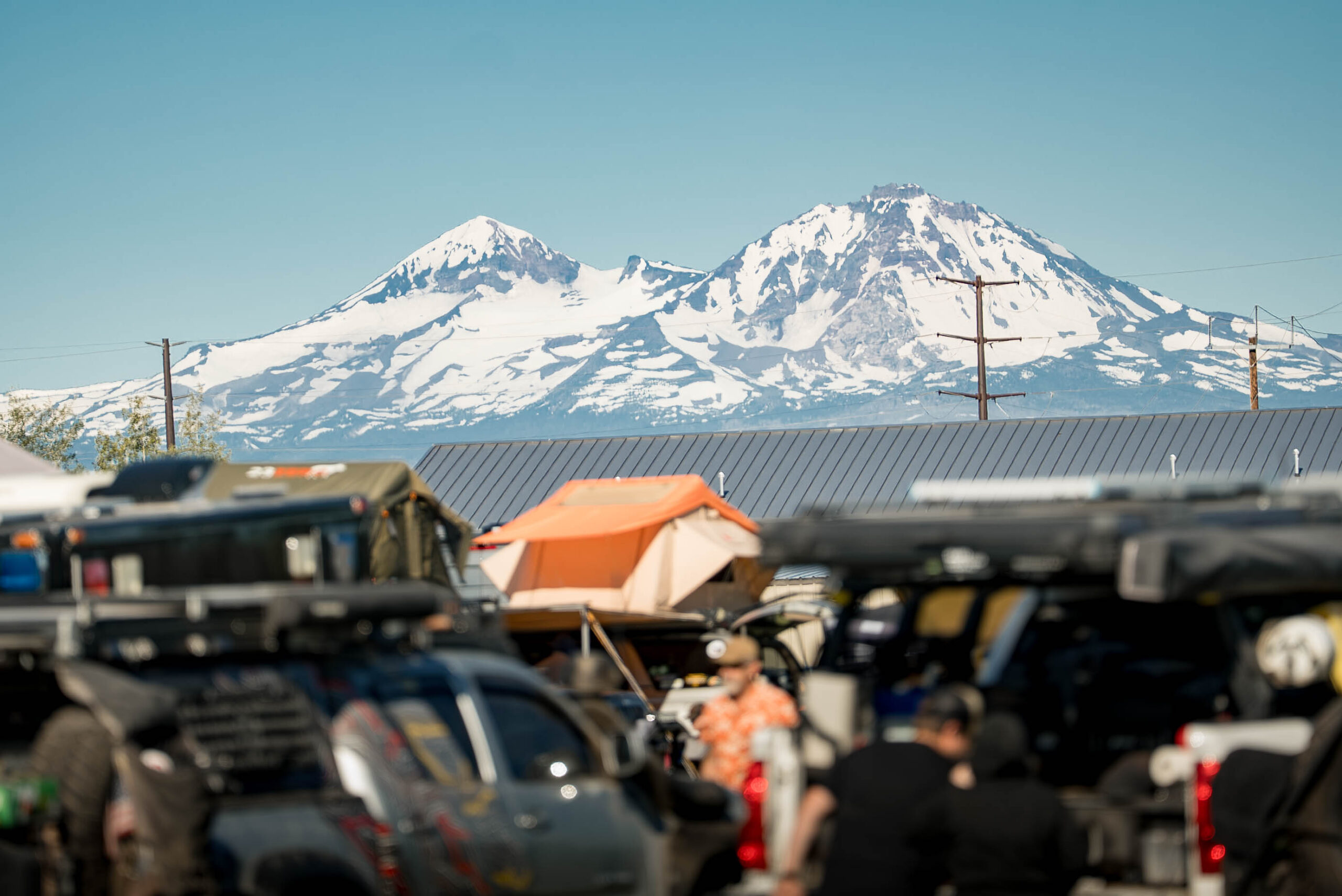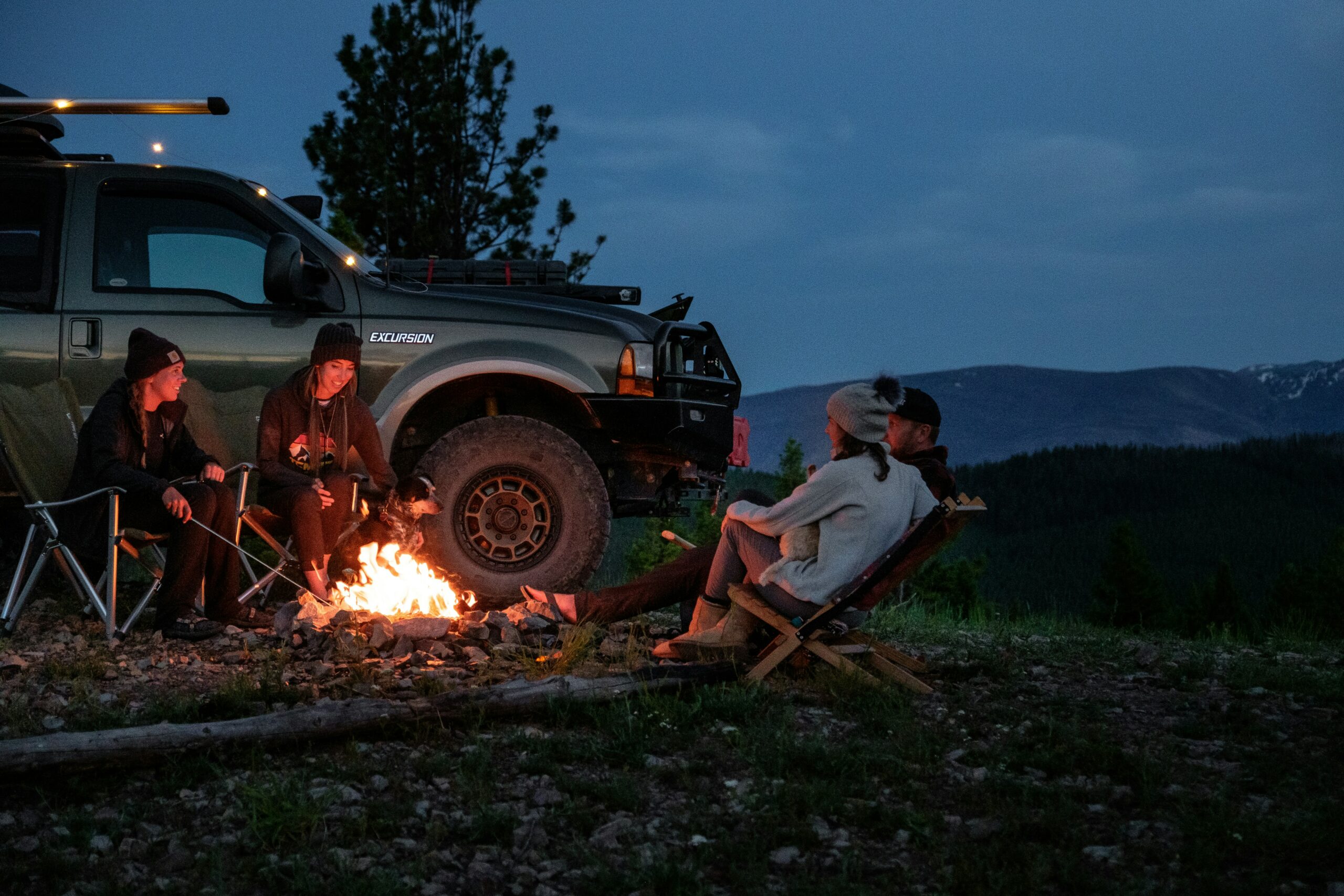My dog, Ruger, and I have been overlanding since 2010. He was just two years old when I discovered overlanding. He’s twelve-and-a-half years old now.
In that time, we’ve been on some pretty incredible adventures together. We’ve summited mountains, reached the depths of canyons, and crossed rivers and deserts alike.
Coonhounds are only supposed to live 10 to 12 years. So, I figure he’s living on borrowed time. Although his muscles are weakening and his hips increasingly arthritic, his spirit remains unchanged. He loves adventure as much at 12 years as he did at 12 months.
Buoyed spirit alone, however, doesn’t prepare a creature — coonhound or otherwise — for prolonged travel. From my rearview mirror, I can see Ruger is all smiles in the back seat when we’re on the trail. I can tell, though, that overlanding is hard for him these days.
Ruger can manage being jostled in the back seat over rough terrain just fine. But there’s one daily overlanding ritual that has become increasingly torturous for my old pup: getting in and out of our rooftop tent.
At some seven feet off the ground, the Roofnest Condor mounted above the bed of my Jeep Gladiator has never been something Ruger can climb into alone. Due to both arthritis and general senility, being ferried up and down the ladder has become increasingly unpleasant for him.
Sometimes I know he’d rather sleep in the back seat of the truck than have me carry him up the ladder into the warm tent. It breaks my heart a little more each time we go on an adventure to know that an essential part of our beloved hobby, climbing into our tent, has become painful for my pup.
That’s why I was so keen to try Rubicon Expedition Products’ Hitch Tent Rack System. It moves a rooftop tent from, well, the roof, down to the ground at about shin height.
Return to Sender
Rubicon Expedition Products sent the Hitch Tent Rack System — with special red anodizing to match the red accents on my Gladiator Rubicon — during the height of the pandemic. At that time, my home state of Oregon was still under its “Stay Home, Save Lives” order. So, rather than violate those orders, I decided to set up an overland-style camp in my backyard for a weekend.
But before I could set up camp, I’d need to assemble the Hitch Tent Rack System.
The Hitch Tent was delivered in a single large box. Cracking it open, I found all of the parts neatly organized in layer upon layer of specially cut foam layers. Admittedly, this isn’t super distinctive. But there’s a twist.
Atop the parts-and-foam pile was a piece of paper emblazoned with a large QR code. Scanning the code with your smartphone loads a webpage on the Rubicon Expedition Products homepage on which the buyer can request a return shipping label.

Photo credit: Nick Jaynes
Once the buyer has retrieved all the Hitch Tent components from the shipping box, they can send the box and all the packaging materials, via UPS, back to Rubicon Expedition Products for reuse — and receive a $65 deposit refund.
Not only does this save the buyer the hassle of disposing of all this foam and cardboard, it prevents those materials from ending up in a landfill — a win-win.
Assembling the Hitch Tent was fairly straightforward. The detailed instructions are printed in color and included in the box. Even folks who are not necessarily ‘handy’ or mechanically inclined should find assembly rather easy.
Admittedly, the most difficult part was lifting the rooftop tent onto the Hitch Tent for installation. Of course, I did this solo despite the instructions calling for me to utilize a friend for that task. But, again, this was during coronavirus lockdown. So, my hands were tied; it had to be a one-man job.
Backyard Overlanding
With my Gladiator loaded with my standard overlanding gear and supplies, I lifted Ruger into the back seat and we made the 30-second drive down to the bottom corner of my property.
Since I keep virtually all my gear in the bed of my Gladiator, the Hitch Tent had to be deployed first before the rest of camp could be set up. Don’t let the complicated appearance of the thing fool you; it is incredibly easy to deploy.
First, pull the pins that keep the legs locked in place while driving. Then swing the legs to their full outright position and reinstall the pins. With the legs deployed and locked, undo the main Hitch Tent coupler clasp and swing it out. With that door open, the Hitch Tent has a clear pathway to swing down to the ground. Lowering the tent from the vertical position down to the ground is easy.
I took setup one step further, since I wanted the Hitch Tent and Roofnest in a different position than I wanted my Jeep. I undid the second portion of the coupler, freeing the hitch ball and thereby the rest of the Hitch Tent from my truck. This enabled me to drive away, leaving the Hitch Tent and Roofnest pairing where I’d set them down.
When I drove down into the gully in which Ruger and I were making camp, I’d tried to find a relatively level spot for the tent. Since it was only mostly flat, I used the Hitch Tent’s extendable legs to further level the tent. This took only a matter of moments to accomplish. Loosen the knobs, pull the legs down to the desired height, and re-torque the knobs — also super easy.
With that done, I cracked a beer, started a fire, and cooked dinner while Ruger explored the yard.
Easy Access
After the sun went down, Ruger and I quietly sat by the campfire. He was on his dog camp-bed and I was in my folding camp-chair. As I stared in the hypnotic glow of the fire, I got lost in my thoughts. Suddenly, I realized Ruger was no longer lounging next to me.
Keen to make sure he wasn’t sniffing out the nearby coyote den, I called for him. I heard the telltale jangle of this collar from just over my right shoulder. I turned to find him lounging in the Roofnest. I grabbed my camera and snapped a few pictures.
Ruger had taken a rawhide bone with him to enjoy in the confines of our trusty rooftop tent — a tent I thought he’d long ago become disillusioned with. My heart warmed at the sight, albeit slightly science-fiction-y with the hue of the Condor’s LED lights. Ruger is old enough now that even climbing onto our couch is hard for him. So, to see him hop up into our tent moved me.
After cleaning up camp, I joined Ruger in the Roofnest atop the Hitch Tent. He saddled up next to me and we dozed off to the sounds of a symphony of crickets from the tall grasses that surrounded our camp.
When I woke up the next morning, Ruger was already awake and keen to explore the yard again. We’ve lived on this property for nearly two years. Somehow camping at the bottom corner of it renewed his fascination with the land. I unzipped the tent and he easily leaped out of the tent by himself — something he’s never been able to do before.

Photo credit: Nick Jaynes
We shared a breakfast of eggs and bacon, our first-morning overland camp ritual, as we sat in a bit of a morning daze and stared blankly at the dewy emerald-green grass at our feet. When a light rain began to fall, I figured it was as good a time as any to pack up camp.
I closed up the Roofnest as quickly as I could, which takes around 90 seconds. I lifted Ruger into the back seat of the Jeep. And I loaded our stuff into the truck bed. Reattaching the Hitch Tent was as easy as detaching it the night before — and about as quick as closing the rooftop tent itself.
I backed the truck up so that the hitch-mounted coupler was within a few inches of the Hitch Tent ball and I lifted the Hitch Tent into the coupler. I closed the first portion around the ball and locked it down. Then I lifted the Hitch Tent and Roofnest off the ground up into the vertical position.

Photo credit: Nick Jaynes
Initially, I worried this would be a bit of a precarious action. It’s not. The Hitch Tent and rooftop tent hold nicely in the vertical position, even before it’s fully latched. In other words, you don’t have to worry about the tent crashing down on you while you’re closing up the final clasp.
With everything nicely stowed, we drove back across the property to our little cottage.
On the Road
Although I’d tested the Rubicon Expedition Products’ Hitch Tent Rack System in its most essential function, I knew I’d have to drive around with it a bit to get the full ownership experience. Still in the height of the pandemic, I didn’t have much of anywhere to go. So, I went for several drives in town. I hit the freeway a few times as well for good measure.
One thing I had virtually expected to experience with the Hitch Tent was an annoying rattling sound or a sense of precariousness in the setup. I was delighted not to hear or feel either. The anti-rattle pin Rubicon Expedition Products designed into the hitch-mounted coupler worked like a charm.
Even though I had a 140-pound hard-shell clamshell rooftop tent mounted vertically behind my truck, even at 65 miles per hour, I felt no sense of insecurity about the Hitch Tent Rack System. It was incredibly solid.
Leave the Tent at Home
At first blush, I wasn’t sure who Rubicon Expedition Products had designed the Hitch Tent Rack System for. It’s ostensibly designed for someone who wants a rooftop tent but also doesn’t want it on their roof. I worried it might be a small buyer market.
Having spent time with it, though, it makes a lot more sense. Not only does the Hitch Tent free up your rig’s roof (or in my case bed rack) for oversized gear — kayaks, for example — it also enhances the accessibility of the rooftop tent itself.

Photo credit: Nick Jaynes
Rooftop tents are incredibly easy to use and comfortable to sleep in. But leveling them out can be a challenge. Getting in and out of them can be a struggle, too.
I don’t know about you, but I’ve definitely had internal debates with myself at 2:30AM about whether I really needed to relieve myself as badly as I thought I did.
“What’s worse,” I’ve thought, “Putting on your boots and climbing down a seven-foot ladder in the dark or holding it another four hours?”
With the Hitch Tent, these sorts of mental arguments simply don’t need to take place.
What’s more, the Hitch Tent Rack System enables overlanders to easily leave their rooftop tent at home when they don’t need it. Arguably, not everyone wants to have a bulky, 140-pound tent permanently mounted on their vehicle. For those folks, Rubicon Expedition Products’ Hitch Tent Rack System is an awesome solution.
I know Ruger is an advocate of the Hitch Tent Rack System.

Header image credit: Nick Jaynes @nickjaynes









